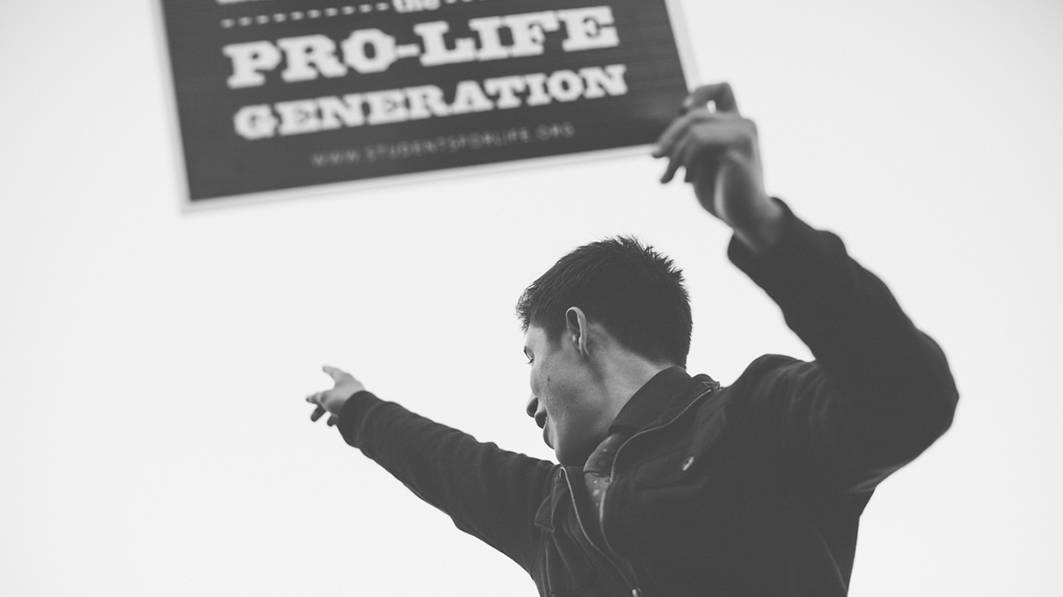Even as Americans grow more disillusioned with the country’s political climate, there is light on the horizon for at least one injustice: abortion.
A new generation, one largely influenced by popular culture and bent toward a liberal belief system, is increasingly pro-life. These young people, known as millennials, no longer blindly buy into longstanding arguments about shapeless blobs of tissue developing in utero. Thanks to advances in technology such as fetal surgery and 3-D imaging, we now have a vivid window into the lives of the preborn — into the womb itself. Indeed, many millennials grew up seeing ultrasound pictures of fully formed younger siblings, and they have a new understanding about when life really begins.
The Data
According to a poll conducted by the Barna Group (for the Institute for Pro-life Advancement), 53 percent of millennials agree that abortion should be made illegal in all or most circumstances. And a 2010 Gallup poll found that “support for making abortion broadly illegal was growing fastest among young adults” (as noted by Charles Camosy in USA Today, March 23, 2015). Only 37 percent of millennials considered abortion morally acceptable in a 2012 PRRI study.
Notable, too, are the reactions of abortion advocates like NARAL Pro-Choice America and EMILY’s List. They are concerned about something former NARAL president Nancy Keenan called the “intensity gap.” As reported in The Washington Post, “In 2010, [NARAL’s] poll of 700 young Americans showed a stark ‘intensity gap’ on abortion. Most anti-abortion voters under 30 (51 percent) considered it a ‘very important’ voting issue. Among abortion-rights millennials, that number stood at 26 percent.” The disparity of this “intensity gap,” pro-lifers suggested, prompted Keenan to resign in 2013 in the hope of finding leadership that could attract younger supporters to NARAL’s cause.
Regarding millennials, Jeanne Mancini, president of the national March for Life, says, “They’re the best evangelists for life because they have zeal and enthusiasm. They cut through the boloney and tell it like it is.”
The Reasons
Another factor behind this opinion shift among young people is that single motherhood lacks the stigma it once held in American society.
“They’ve grown up seeing ‘getting pregnant’ celebrated, and even when it’s unexpected, people don’t look the same way at single mothers,” says Kristan Hawkins, president for Students for Life. “A woman no longer has to think that abortion is her only option if her boyfriend doesn’t want to support her.”
Hawkins says high divorce rates among parents of millennials and the instability of their home life have affected their perceptions about what it takes to raise a child. Hawkins says the mindset is often, “You may be single and the dad may not be ready to be a father, or he may bail out and refuse to help, but that does not give you a reason to have an abortion.”
“We know children need fathers and mothers,” Hawkins says, “but that’s not the reality we always live in.”
The shift in attitudes toward abortion could also be attributed to widespread media coverage.
“In the late 1990s and early 2000s we had for the first time an abortion procedure (partial-birth abortion) that was debated before Congress and it got tons of coverage,” Mancini says. “Before that, people didn’t really know what happened in an abortion — it was known as ‘a health procedure.’ When it was actually shown, this depiction of a ‘health procedure’ horrified the American people.”
Media coverage in recent years has likely played a role in shifting public opinion as well. The case of Kermit Gosnell, a Philadelphia abortion doctor who was convicted of murdering several babies outside the womb by snipping their spinal cords, made news across the country. Moreover, Gosnell overdosed his patients, used dirty instruments and was found guilty for the death of a female patient at his clinic.
Another recent high profile case involved undercover videos showing a Planned Parenthood official trying to sell baby hearts and livers – over lunch – to a pro-life activist posing as a biotech firm representative.
People are seeing that abortion “is a dark industry, and there’s not always good motivations going on there,” Mancini says. As a result, the public is starting to ask a lot of questions.
Social and Digital Media
Millennials are passionate about social justice — and they’re influenced by social and digital media. For example, a project by the pro-life group Live Action used iPads to show the reality of an abortion procedure to “pro-choice” college students and gauged their reactions through a series of questions. Live Action then posted a video of the students’ responses to YouTube. Needless to say, many of the students changed their minds after being confronted with the facts about the procedure.
“They’ve come from a generation where they can enact change, and they’ve seen change happen through a Twitter campaign or through somebody who you would not think could have a huge impact on our world,” Hawkins says.
Identification Politics
“The demographic writing is on the wall,” says Charles Camosy, associate professor of theological and social ethics at Fordham University and author of Beyond the Abortion Wars: A Way Forward for a New Generation. “The next generation of Americans coming into their own, dominated by millennials and Latinos, is disproportionately skeptical of abortion. This is not only because they’ve grown up with technology which reveals the humanity of prenatal children in ways that are impossible to deny, but because they are not beholden to right/left categories. This new generation is not partisan, but it is most definitely pro-life.”
And there’s the rub. While millennials increasingly oppose abortion, they don’t necessarily support other issues normally associated with a pro-family agenda, such as traditional marriage, fiscal conservatism and religious freedom.
“This younger generation does not want to be a part of the traditional abortion debate — and the traditional movements associated with it,” says Camosy. “They may oppose abortion, but support for women is a big part of the equation. They express unwavering support for affordable and quality child care, paid paternal leave and gender equality in the workplace.”
Hawkins from Students for Life echoes this sentiment. “Our staff is racially diverse, religiously diverse and politically diverse,” she says. “It’s not all conservative. But we agree on the core principles: Every human life is valuable and intrinsically so, and that all life should be protected and abortion should be abolished in our country. Yes, these millennials are anti-abortion, but these are not Republicans and they don’t consider themselves pro-life. They don’t call themselves anything. Labels do not have meaning for them except for the one that is most politically acceptable.”
“I’ve sat in on focus groups about this (identification issue),” Mancini continues, “and if you drill down on what ‘pro-life’ or ‘pro-choice’ means, so many people don’t know. So they may call themselves pro-choice, but the truth of that is that in 99 percent of situations they’re actually quite pro-life. When you ask questions such as ‘Well, do you believe a baby is a life? Do you believe abortion should be legal in all trimesters?’ it changes the dynamic.”
Reaching Millennials
“The pro-life movement has a golden opportunity with a new generation which already believes much of what we stand for already,” says Camosy. “But we must reach out to them in nonpartisan ways that they can hear. We must have a movement friendly to Latinos and other people of color. In short, we just need to be smart and open-minded in how we convey the pro-life message to a new generation.”
Hawkins has this advice for pro-lifers: “Help them see it’s a human rights issue. Make them see that abortion is just as much of an injustice to [the mother] as it is for her child. They may agree, ‘Yeah, it’s a baby, but it doesn’t have any rights.’ This allows for a larger philosophical conversation on who determines rights, and what happens when you have varying rights and what that means and how scary that is. Look, we’re a First World nation; is this the best we can do for women? How can we not figure out a way to support a woman and her child?”
Hawkins’ Students for Life now has 1,000 chapters on college campuses, a fact she’s not shy about sharing. “You can’t have a winning social movement with a message that you’re losing. We bring momentum, and momentum brings people into our movement.”
“A life is a life, and you just can’t erase a life,” says Mancini. “Millennials have that sense about them today. They know truth and can spot someone who’s not telling the truth right in front of them. At the March for Life, one of the most popular chants is from young people: ‘We are the pro-life generation!’ It’s very moving to see tens of thousands of young people chanting — and you really believe they will bring an end to this human rights abuse.”



















